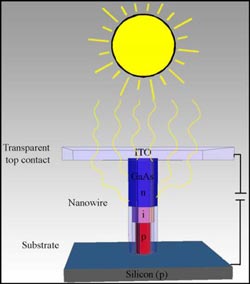Nanowire solar cells raise efficiency limit

The figure shows that the sun's rays are drawn into a nanowire, which stands on a substrate. At a given wavelength the sunlight is concentrated up to 15 times. Consequently, there is great potential in using nanowires in the development of future solar cells.<br><br>Credit: (credit: Niels Bohr Institute)<br>
Due to some unique physical light absorption properties of nanowires, the limit of how much energy we can utilize from the sun's rays is higher than previous believed. These results demonstrate the great potential of development of nanowire-based solar cells, says PhD Peter Krogstrup on the surprising discovery that is described in the journal Nature Photonics.
The research groups have during recent years studied how to develop and improve the quality of the nanowire crystals, which is a cylindrical structure with a diameter of about 10,000 part of a human hair. The nanowires are predicted to have great potential in the development not only of solar cells, but also of future quantum computers and other electronic products.
It turns out that the nanowires naturally concentrate the sun's rays into a very small area in the crystal by up to a factor 15. Because the diameter of a nanowire crystal is smaller than the wavelength of the light coming from the sun it can cause resonances in the intensity of light in and around nanowires. Thus, the resonances can give a concentrated sunlight, where the energy is converted, which can be used to give a higher conversion effeciency of the sun's energy, says Peter Krogstrup, who with this discovery contributes to that the research in solar cell technology based on nanowires get a real boost.
New efficiency limit
The typical efficiency limit – the so-called “Shockley-Queisser Limit” – is a limit, which for many years has been a landmark for solar cells efficiency among researchers, but now it seems that it may be increased.
It's exciting as a researcher to move the theoretical limits, as we know. Although it does not sound like much, that the limit is moved by only a few percent, it will have a major impact on the development of solar cells, exploitation of nanowire solar rays and perhaps the extraction of energy at international level. However, it will take some years years before production of solar cells consisting of nanowires becomes a reality, says Peter Krogstrup who just completed his PhD at the Niels Bohr Institute, University of Copenhagen.
The research is conducted in collaboration with the Laboratory des Matériaux Semiconducteurs, Ecole Polytechnique Fédérale de Lausanne, the Foundation and the company SunFlake A / S. Their scientific findings work support results published in the journal Science in January. Here, a group of researchers from Lund, showed that the sun's rays was sucked into the nanowires due to the high amount of power that their solar cell produced.
For more information contact:
Peter Krogstrup, PhD
Niels Bohr Institute, University of Copenhagen
45-2671-5191
krogstrup@fys.ku.dk
Rikke Bøyesen, communication officer
Nano-Science Center, University of Copenhagen
45-2875-0413
rb@nano.ku.dk
Media Contact
More Information:
http://www.ku.dkAll latest news from the category: Power and Electrical Engineering
This topic covers issues related to energy generation, conversion, transportation and consumption and how the industry is addressing the challenge of energy efficiency in general.
innovations-report provides in-depth and informative reports and articles on subjects ranging from wind energy, fuel cell technology, solar energy, geothermal energy, petroleum, gas, nuclear engineering, alternative energy and energy efficiency to fusion, hydrogen and superconductor technologies.
Newest articles

Security vulnerability in browser interface
… allows computer access via graphics card. Researchers at Graz University of Technology were successful with three different side-channel attacks on graphics cards via the WebGPU browser interface. The attacks…

A closer look at mechanochemistry
Ferdi Schüth and his team at the Max Planck Institut für Kohlenforschung in Mülheim/Germany have been studying the phenomena of mechanochemistry for several years. But what actually happens at the…

Severe Vulnerabilities Discovered in Software to Protect Internet Routing
A research team from the National Research Center for Applied Cybersecurity ATHENE led by Prof. Dr. Haya Schulmann has uncovered 18 vulnerabilities in crucial software components of Resource Public Key…





















